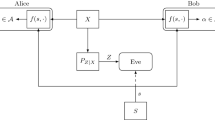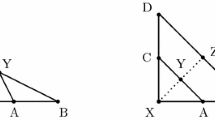Abstract
Large sets of combinatorial designs has always been a fascinating topic in design theory. These designs form a partition of the whole space into combinatorial designs with the same parameters. In particular, a large set of block designs, whose blocks are of size k taken from an n-set, is a partition of all the k-subsets of the n-set into disjoint copies of block designs, defined on the n-set, and with the same parameters. The current most intriguing question in this direction is whether large sets of Steiner quadruple systems exist and to provide explicit constructions for those parameters for which they exist. In view of its difficulty no one ever presented an explicit construction even for one nontrivial order. Hence, we seek for related generalizations. As generalizations, to the existence question of large sets, we consider two related questions. The first one is to provide constructions for sets on Steiner systems in which each block (quadruple or a k-subset) is contained in exactly \(\mu \) systems. The constructions of such systems also yield secure protocols for the generalized Russian cards problem. The second question is to provide constructions for large set of H-designs (mainly for quadruples, but also for larger block size), which have applications in threshold schemes and in quantum jump codes. We prove the existence of such systems for many parameters using orthogonal arrays, perpendicular arrays, ordered designs, sets of permutations, and one-factorizations of the complete graph.
Similar content being viewed by others
References
Baranyai Z.: On the factorization of the complete uniform hypergraph. In: Hajnal A., Rado T., Sbs T. (eds.) Infinite and Finite sets, pp. 91–108. North-Holland, Amsterdam (1975).
Bierbrauer J.: Monotypical uniformly homogeneous sets of permutations. Arch. math. 58, 338–344 (1992).
Bierbrauer J.: The uniformly 3-homogeneous subsets of PGL\((2, q)\). J. Algebra Combin. 4, 99–102 (1995).
Bierbrauer J.: Ordered designs, perpendicular arrays, and permutation sets. In: Colbourn C.J., Dinitz J.H. (eds.) The CRC Handbook of Combinatorial Designs, pp. 543–547. John Wiley, New York (2006).
Bierbrauer J., Black S., Edel Y.: Some \(t\)-homogeneous sets of permutations. Des. Codes Cryptogr. 9, 29–38 (1996).
Bierbrauer J., Edel Y.: Theory of perpendicular arrays. J. Comb. Des. 2, 375–406 (1994).
Bierbrauer J., Edel Y.: Halving PSL\((2, q)\). J. Geom. 64, 51–54 (1999).
Bierbrauer J., van Trung T.: Halving PGL\((2,2^f)\), \(f\) odd: a series of cryptocodes. Des. Codes Cryptogr. 1, 141–148 (1991).
Bierbrauer J., van Trung T.: Some highly symmetric authentication perpendicular arrays. Des. Codes Cryptogr. 1, 307–319 (1991).
Blackburn S. R., Etzion T.: Block-avoiding point sequencings. J. Comb. Des. 29, 339–366 (2021).
Cameron P.J.: Permutation groups. Handb. Comb. 1, 611–645 (1995).
Chee Y. M., Etzion T., Kiah H. M., Vardy A., Wang C.: Explicit Baranyai partitions for quadruples, part I: quadrupling constructions. J. Comb. Des. https://doi.org/10.1002/jcd.21776. (to appear)
Chen D., Lindner C.C., Stinson D.R.: Further results on large sets of disjoint group-divisible designs. Discret. Math. 110, 35–42 (1992).
Etzion T.: On threshold schemes from large sets. J. Comb. Des. 4, 323–338 (1996).
Etzion T., Hartman A.: Towards a large set of Steiner quadruple systems. SIAM J. Discret. Math. 4, 182–195 (1991).
Etzion T., Zhou J.: An improved recursive construction for disjoint Steiner quadruple systems. J. Comb. Des. 28, 551–567 (2020).
Finucane H., Peled R., Yaari Y.: A recursive construction of \(t\)-wise uniform permutations. Random Struct. Algorithms 46, 531–540 (2015).
Ge G., Zhu L.: Authentication perpendicular arrays APA\(_1(2, 5, v)\). Des. Codes Cryptogr. 4, 365–375 (1996).
Granville A., Moisiadis A., Rees R.S.: Nested Steiner \(n\)-cycle systems and perpendicular arrays. J. Combin. Math. Combin. Comput. 3, 163–167 (1988).
Hartman A.: The fundamental construction for 3-designs. Discret. Math. 124, 107–132 (1994).
Hartman A., Mills W.H., Mullin R.C.: Covering triples by quadruples: an asymptotic solution. J. Combin. Theory A 41, 117–138 (1986).
Hedayat A.S., Sloane N.J.A., Stufken J.: Orthogonal Arrays: Theory and Applications. Springer, New York (1999).
Ji L.: A new existence proof for large sets of disjoint Steiner triple systems. J. Comb. Theory A 112, 308–327 (2005).
Ji L.: An improvement on H design. J. Comb. Des. 17, 25–35 (2009).
Ji L.: A complete solution to existence of H designs. J. Comb. Des. 27, 75–81 (2019).
Keevash P.: The existence of designs II. arXiv:1802.05900 (2018).
Kotzig A., Lindner K., Rosa A.: Latin squares with no subsquares of order two and disjoint Steiner triple systems. Utilias Math. 7, 287–294 (1975).
Kramer E.S., Wu Q.-R., Magliveras S.S., van Trung T.: Some perpendicular arrays for arbitrarily large \(t\). Discret. Math. 96, 101–110 (1991).
Kuperberg G., Lovett S., Peled R.: Probabilistic existence of regular combinatorial structures. Geom. Funct. Anal. 27, 919–972 (2017).
Lei J.: Completing the spectrum for LGDD\((m^v)\). J. Comb. Des. 5, 1–11 (1997).
Lindner C.C.: A note on disjoint Steiner quadruple systems. Ars Comb. 3, 271–276 (1977).
Lindner C.C.: On the construction of pairwise disjoint Steiner quadruple systems. Ars Comb. 19, 153–156 (1985).
Lu J. X.: On large sets of disjoint Steiner triple systems, I–III. J. Comb. Theory A 34, 140–146, 147–155, 156–182 (1983)
Lu J. X.: On large sets of disjoint Steiner triple systems, IV – VI. J. Comb. Theory A 37, 136–163, 164–188, 189–192 (1984)
Martin W.J., Sagan B.E.: A new notion of transitivity for groups and sets of permutations. J. Lond. Math. Soc. 73, 1–13 (2006).
Mills W. H.: On the covering of triples by quadruple. In: Proc. of the Fifth Southeastern Conference on Combinatorics Graph Theory and Algorithms, pp. 573–581 (1974)
Mills W.H.: On the existence of H designs. Congr. Numer. 79, 129–141 (1990).
Mullin R.C., Schellenberg P.J., van Rees G.H.J., Vanstone S.A.: On the construction of perpendicular arrays. Utilitas Math. 18, 141–160 (1980).
Peltesohn R., dreien Das Turnieroblem für spiele zu je: Inaugural dissertation, Berlin (1936)
Raghavarao D.: Constructions and Combinatorial Problems in the Design of Experiments. Wiley, New York (1971).
Rao C.R.: Combinatorial arrangements analogous to orthogonal arrays. Sankhyā A23, 283–286 (1961).
Schellenberg P.J., Stinson D.R.: Threshold schemes from combinatorial designs. J. Comb. Math. Comb. Comput. 5, 143–160 (1989).
Stinson D.R.: The combinatorics of authentication and secrecy codes. J. Cryptol. 2, 23–49 (1990).
Stinson D.R., Vanstone S.A.: A combinatorial approach to threshold schemes. SIAM J. Discret. Math. 1, 230–236 (1988).
Swanson C.M., Stinson D.R.: Combinatorial solutions providing improved security for the generalized Russian cards problem. Des. Codes Cryptogr. 72, 345–367 (2014).
Teirlinck L.: Non-trivial \(t\)-designs without repeated blocks exist for all \(t\). Discret. Math. 65, 301–311 (1987).
Teirlinck L.: On large sets of disjoint ordered designs. Ars Comb. 25, 31–37 (1988).
Teirlinck L.: Locally trivial designs and \(t\)-designs without repeated blocks. Discret. Math. 77, 345–356 (1989).
Teirlinck L.: A completion of Lu’s determination of the spectrum for large sets of disjoint Steiner triple systems. J. Comb. Theory A 57, 302–305 (1991).
Teirlinck L.: Large sets with holes. J. Comb. Des. 1, 69–94 (1993).
Wallis W.D.: One-factorizations. Kluwer Academic Publisher, New York (1997).
Zhou J., Chang Y.: Bounds and constructions of \(t\)-spontaneous emission error designs. Des. Codes Cryptogr. 85, 249–271 (2017).
Acknowledgements
We are indebted to Doug Stinson who brought to our attention his paper [45] on the Russian cards problem. This problem has given further motivation for our constructions of large sets with multiplicity. We are also indebted to a reviewer which read our draft very carefully and gave many constructive comments which amended this paper.
Author information
Authors and Affiliations
Corresponding author
Additional information
Communicated by L. Teirlinck.
Publisher's Note
Springer Nature remains neutral with regard to jurisdictional claims in published maps and institutional affiliations.
This research was supported in part by the 111 Project of China (B16002) and in part by the NSFC grants 11571034 and 11971053. Part of the research was performed during a visit of T. Etzion to Beijing Jiaotong University. He expresses sincere thanks to the 111 Project of China (B16002) for its support and to the Department of Mathematics at Beijing Jiaotong University for their kind hospitality. T. Etzion was also supported in part by the Bernard Elkin Chair in Computer Science.
Rights and permissions
About this article
Cite this article
Etzion, T., Zhou, J. Large sets with multiplicity. Des. Codes Cryptogr. 89, 1661–1690 (2021). https://doi.org/10.1007/s10623-021-00878-4
Received:
Revised:
Accepted:
Published:
Issue Date:
DOI: https://doi.org/10.1007/s10623-021-00878-4
Keywords
- H-designs
- Large sets
- Latin squares
- One-factorizations
- Ordered designs
- Permutations
- Perpendicular arrays
- Steiner systems




